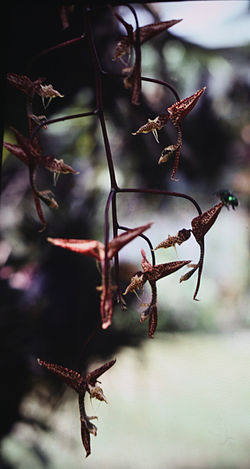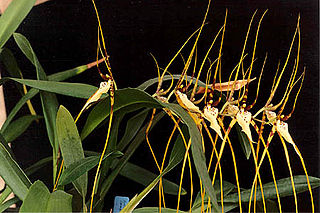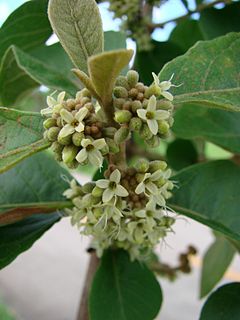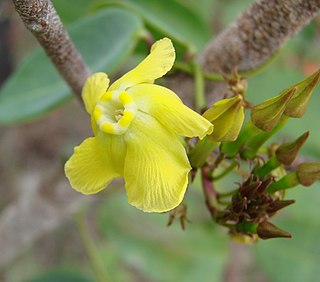| Gongora | |
|---|---|
 | |
| Gongora latisepala | |
| Scientific classification | |
| Kingdom: | Plantae |
| Clade: | Tracheophytes |
| Clade: | Angiosperms |
| Clade: | Monocots |
| Order: | Asparagales |
| Family: | Orchidaceae |
| Subfamily: | Epidendroideae |
| Tribe: | Cymbidieae |
| Subtribe: | Stanhopeinae |
| Genus: | Gongora Ruiz & Pav. (1794) |
| Species | |
See text | |
| Synonyms | |
AcroperaLindl. | |
Gongora, abbreviated Gga in horticultural trade, is a member of the orchid family (Orchidaceae). It consists of 65 species known from Central America, Trinidad, and tropical South America, with most species found in Colombia. They grow across a wide geographical range, from wet forests at sea level, to mountainous regions in the Andes, as high as 1,800 m.
Contents
The name comes from Antonio Caballero y Gongora, a viceroy of New Granada (Colombia and Ecuador) and the governor of Peru during the Ruiz and Pavón botanical expedition. [1]
Gongora was one of the first orchids described by a European.[ citation needed ] Several new Gongora orchids have been discovered in the 2000s-2010s, whilst many others have been re-grouped under different classifications. Yet there is still some confusion; Many species lack "appropriate" descriptions. Some species, such as Gongora portentosa and Gongora superflua, are extremely isolated in population. DNA fingerprinting will, in time, contribute to an exact taxonomy of this genus.
All species in this genus are epiphytes, with a sympodial growth. The white aerial roots are very thin, growing in a dense mound. Some roots will travel, seeking out additional anchoring and nutrients, growing vertically/sideways rather than simply hanging down. This specialisation helps in forming the anchorage of the plant to its "host" tree.
Many of these orchids are found in association with ant nests; the ants are, in turn, attracted to nectar droplets from the plant, as well as any pest insects (aphid, mealybug, etc.) that may be present on the orchid. However, the ants do not prey on these pests; the bugs suck sap from the orchid (or any plant), and ultimately create waste excrement in the form of a "sweet" liquid, referred to as honeydew. Ants find this addicting; they will meticulously maintain the pest insect's population by caring for them, and guarding them, on the orchid plant. Whenever an ant is fatigued, they will simply approach an aphid/mealybug and "tap" its abdomen, communicating they are ready to "feed". [2]
The conical pseudobulbs are ridged and are about 8 cm long. In some species, such as Gongora similis, the pseudobulb can produce up to six inflorescences in succession. Two alternate leaves originate from the end of each pseudobulb. The leaves are rather leathery and heavily veined, growing to a length of about 30 cm.
The racemose inflorescence grows from the base of the pseudobulbs. The stem first grows upright, but bends early in development and becomes pendulous. The numerous flowers hang upside down, with the lip upwards. The almost circularly bent pedicels are characteristic of this genus. There are two lateral sepals and one dorsal sepal. The blooms of several species are waxy. The flowers of many species have distinctive fragrances. Some smell like unburned candle wax, others like nutmeg, cardamom, or cinnamon. The pollinia are superposed on a stipe (a cellular pollinium stalk), which is held by a viscid disc.
The genus is closely related to Cirrhaea . For other relatives see also Stanhopeinae & Coeliopsidinae .























